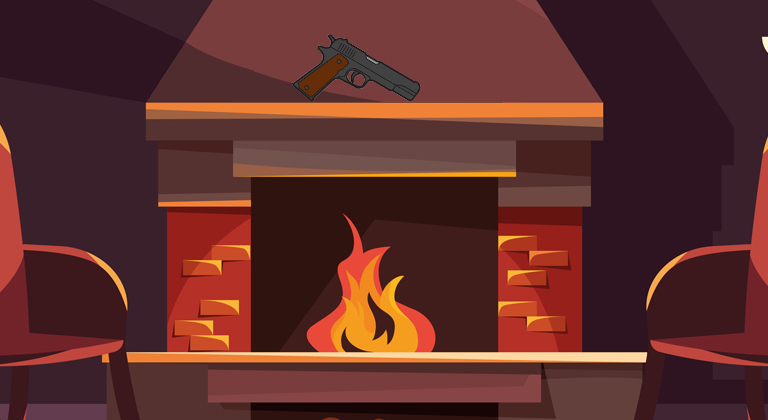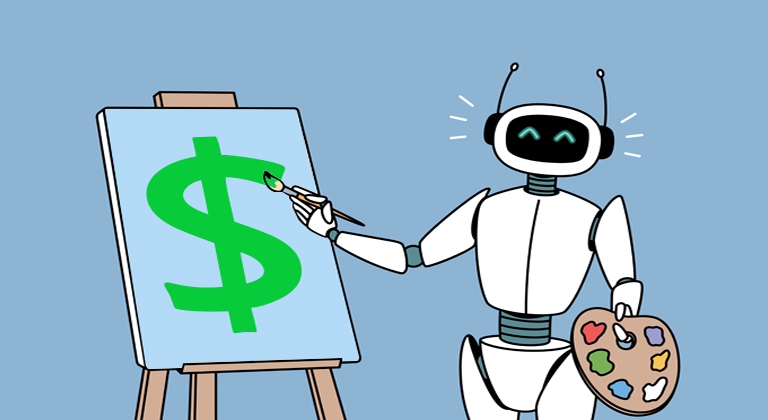Why You Shouldn’t Leave Chekhov’s Gun Hanging On The Wall
Writing is a craft, with authors employing a variety of tools and techniques to weave together their stories. One such tool is Chekhov’s Gun, a principle that essentially emphasizes that every element introduced in a story should serve a purpose, or it shouldn’t be there at all. Today, Ginger is digging into the details of this technique and how it can be used in your own work, along with examples of how it has been used in popular literature and film.
Checkhov’s Gun is all about discipline, foreshadowing, and rewarding your readers for their attention to detail. Whether it’s a clue hidden in the first chapter, a character’s flaw that leads to their downfall, or a seemingly innocuous object that becomes critical later on, this tool can add layers of suspense, symbolism, and satisfaction that will transform your stories from good to unforgettable.
Writing is a craft, not an art – and as craftsmen, we writers employ tools and techniques when we’re crafting a story in exactly the same way a carpenter uses tongue and groove or half-lap joinery when building a table.
One tool a writer might use is something called a “Chekhov’s Gun” – named for Anton Chekhov, a renowned Russian playwright and short story writer frequently considered to be one of the greatest masters of the short story form – known for his realistic and often tragic depictions of human life.
(And I mean tragic even by Russian standards!)
Chekhov famously warned writers: “If you say in the first act that there is a gun hanging on the wall, then in the second or third act it must go off. If it doesn’t go off, then it shouldn’t be hanging there.”
This principle, now known as Chekhov’s Gun, has become a fundamental tenet of good storytelling. It rewards audiences who pay attention to every detail, no matter how seemingly inconsequential – and it can be a powerful tool for foreshadowing in fiction.
Who Was Anton Chekhov?
Anton Pavlovich Chekhov was born on the coast of the Sea of Azov in 1860, and rose to become a prominent figure in Russian literature, celebrated for his realistic short stories and plays. His works often explored themes of human nature, love, loss, and the complexities of life. Chekhov’s writing style was characterized by its simplicity, subtlety, and ability to evoke powerful emotions through understated language – and it was also famous for ensuring that everything of importance is always right there in the narrative.
The Concept of Chekhov’s Gun
Chekhov’s Gun refers to the idea that any element introduced into a story should serve a purpose and be relevant to the plot. If an object or detail is mentioned or shown early on, it should ultimately play a significant role in the story’s resolution. This principle rewards those who pay attention to detail and creates a sense of tension, anticipation, and satisfaction for the observant reader. It also demands discipline from the writer – forcing them to sacrifice details and description that are irrelevant to the plot.
How Chekhov’s Gun is Used in Fiction
Chekhov’s Gun can be used in various ways to enhance storytelling:
- Foreshadowing: By introducing something early on that later becomes significant to the story, authors can hint at future events, creating suspense and anticipation in the reader.
- Symbolism: Objects or details can represent deeper themes or ideas, adding layers of meaning to the story. A gun represents the sudden finality of death, for example – and having it hanging on the wall warns the audience that the promise of death hangs right alongside it.
- Characterization: The way characters interact with objects or details can reveal their personalities and motivations. A character acting carelessly with a gun, for example, is demonstrating that they have a careless attitude to life and death.
- Plot Development: Because it’s always destined to be fired, Chekhov’s Gun should ultimately always be used to drive the plot forward, creating cause-and-effect relationships between characters and events.
Examples of Chekhov’s Gun in Fiction
- The Literal Chekhov’s Gun: In Chekhov’s own play The Three Sisters, a gun is prominently displayed on the wall. It later goes off, symbolizing the characters’ unfulfilled desires and the tragic nature of their lives.
- The MacGuffin: Alfred Hitchcock famously popularized the concept of the MacGuffin, a plot device that drives the story forward but is ultimately unimportant. However, even a MacGuffin can function as a Chekhov’s Gun, as it often sets events in motion and creates tension, or raises the stakes or demands a sacrifice from the main character later on.
- The Clue in the First Chapter: In Agatha Christie’s detective novels, clues are often introduced early on, challenging the reader to solve the mystery alongside the protagonist. You collect them along the way, and they only make sense when they’re all assembled together.
- The Character’s Weakness: In many stories, a character’s flaw or weakness is introduced early on, foreshadowing their eventual downfall or redemption. Indiana Jones has his fear of snakes revealed in the cold open of the movie, for example, and it foreshadows him being entombed with thousands of deadly asps later in the movie.
- The Setting: The setting of a story can be a Chekhov’s Gun itself, influencing the characters’ actions and shaping the plot. It could be a spaceship doomed to crash, a farm on the cusp of an abundant harvest, or any other location marked by the inevitability of future events.
- The Dialogue: A seemingly insignificant conversation can hint at future events or reveal hidden motivations. In Aliens, for example, the main character of Ripley wants to be useful to the Space Marines she’s flying with, and points out that she’s got a “Class 2 rating” with the mechanical power loader they use. This pays off at the climax of the movie, when her aptitude with the power loader lets her fight mano a mano (which means “hand to hand”, not “man to man”) with the fearsome alien queen.
- The Object with a Past: An object with a history or significance can become a Chekhov’s Gun, adding depth and meaning to the story. Just think of Luke Skywalker when he picks up his father’s lightsaber for the first time in Star Wars. The weapon was cut from the hand of Anakin Skywalker just as Darth Vader would later cut it from Luke’s hand in The Empire Strikes Back.
- The Supernatural Element: In horror and fantasy genres, supernatural elements introduced early on often play a crucial role in the resolution of the plot. Ghosts are often introduced as spooky noises and slamming doors rather than the horrific terrifying apparitions they reveal themselves as at the climax of the story.
- The Character’s Secret: A secret revealed or hinted at early on can create tension and anticipation. This was one of the things Star Wars: The Acolyte did right – hinting at the secrets Master Sol was hiding, and how destructive those secrets would be when finally revealed to his former Padawan, Osha.
- The Unexpected Twist: A seemingly insignificant detail can be revealed to have a major impact on the story later on, creating a satisfying twist. A great example is the unreliability of the DeLorean sports car in Back to the Future – suggested at the time as nothing more than a characteristic quirk of European automobiles, but later nearly ruining Marty McFly’s attempts to return home.
Tips for Incorporating Chekhov’s Gun in Your Own Stories
If I’ve whet your appetite for using Chekhov’s Gun in your current or future stories, here are some things to think about:
- Plan Ahead: Think carefully about the elements you want to introduce and how they’ll ultimately connect to the plot.
- Make it Relevant: Ensure that the elements you introduce are meaningful and contribute to the overall story. A Chekov’s Gun that goes unfired is a Red Herring.
- Create Tension: Use Chekhov’s Gun to build anticipation and suspense. A gun is a great example to use because it’s a tool that could become deadly.
- Avoid Overuse: Don’t overload your story with too many Chekhov’s Guns, as it can become overwhelming. While they prove very satisfying for a reader, it pulls you out of the flow of the story if there are too many details you’re trying to keep track of while you read it.
- Be Subtle: Sometimes, the most effective Chekhov’s Guns are those that are subtly introduced. This makes them especially satisfying when they’re “fired” later in the story.
- Consider the Theme: Chekhov’s Gun can be used to reinforce the underlying theme of your story. Symbolism is another powerful tool for writers, and it combines well with the foreshadowing of Chekhov’s Gun.
- Pay Attention to Details: Using Chekhov’s Gun requires discipline as a writer. Now, every detail in your story should have a purpose, even if it’s a small one. You can’t afford to hang metaphorical guns on the wall if they’re not going to go off.
- Avoid Chekhov’s Rifle: On the same topic, in Chekhov’s play The Cherry Orchard there are two rifles featured that never get fired. As a result, this is often held up as a failure of the principle of Chekhov’s Gun – defined as an element that is introduced but never resolved, and sometimes referred to as “Chekhov’s Rifle.”
- Experiment: Don’t be afraid to try different approaches to Chekhov’s Gun. You don’t have to use a literal gun, and a line of dialogue can be as meaningful to the concept as an actual, physical object.
- Get Feedback: When you share your work with other readers for the first time, ask for their opinions on how you’ve used Chekhov’s Gun. You’ll be surprised what beta readers and ARC audiences pick up on that you might not have noticed even as you wrote it!
Conclusion
Chekhov’s Gun is a powerful storytelling tool that can enhance your fiction and create a more satisfying reading experience. By carefully planning and incorporating this principle into your work, you can elevate your writing and connect with your audience on a deeper level.
And as a self-published author, you have the unique opportunity to experiment with different storytelling techniques like this as you search to find your own voice. Don’t be afraid to take risks and try new writing techniques to add deeper layers to your tales. By understanding and applying the concept correctly, you can create stories that are even more engaging and meaningful.
Have you seen examples of Chekhov’s Gun in your favorite books, movies, or TV shows? Which are your favorites? And what are your own experiences with incorporating Chekhov’s Gun into your writing? I encourage you to leave a comment below and share your thoughts!











